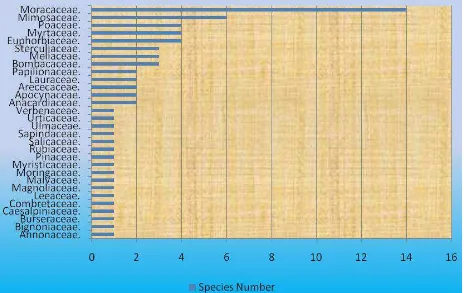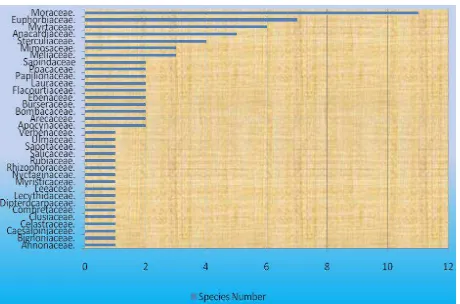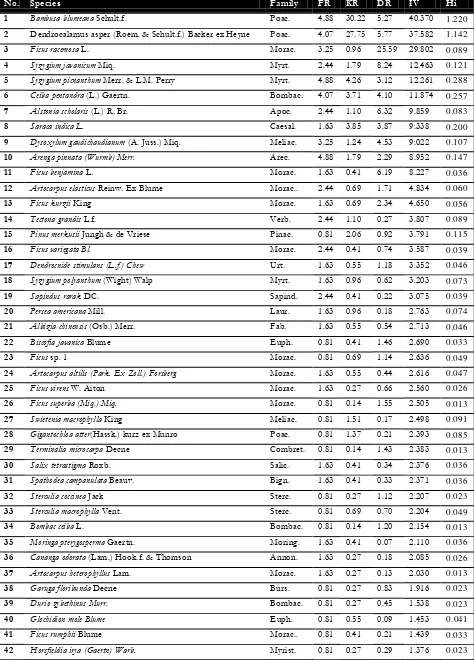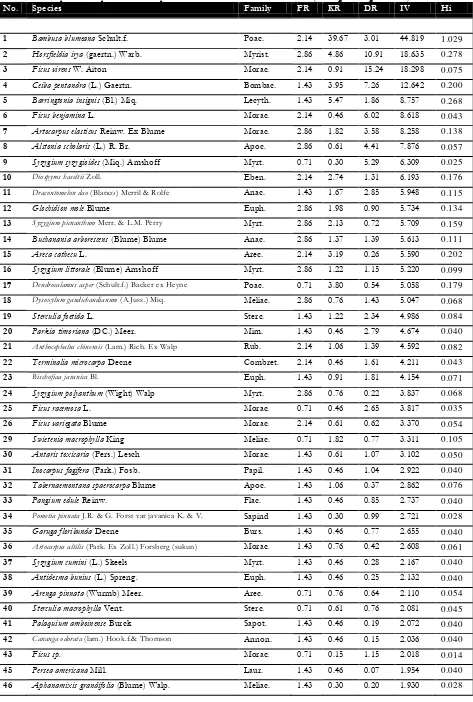VOL. 2, NO. 2, pp. 110 – 118, September, 2012
Composition of Trees Grown Surrounding Water Springs at Two Areas
in Purwosari Pasuruan, East Java
Soejono
Purwodadi Botanic Garden-Indonesian Institute of Sciences
ABSTRACT
The aim of the research was to find out the composition of trees grown surro unding water springs at two areas in Purwosari, Pasuruan, East Java. Eleven plots for each area were observed. The data were analyzed using Mueller-Dombois’s method to calculate their importance value indexes, while Shannon-Wiener’s formula was used for determining the diversity index. The coordinate and altitude of every water spring or its group’s site was determined using Geographical Position System (GPS) to know their positions on the map. The result indicated that there were at least 30 families, 49 g enera which consisted of 68 species of trees grown surrounding water springs at the first area with 5.49 of diversity index, while the second area, consisted of 34 families, 63 genera and 79 species of trees with 5.24 diversity index. The diversity of trees species from Moraceae was the highest among other families, both at the first and the second area, whereas, trees species having a significant important value index included Bambusa blumeana, Dendrocalamus asper, Ficus racemosa, Horsfieldia irya and Ficus virens. The position of the springs in the two areas within the sub-districts of Purwosari is in the range of 7º44'448 " south latitude; 112º44'353" east longitude up to 7º46'339 " south latitude; 112º41’190" east longitude at an altitude between 251 and 522 m above sea level. We hope that the information can be used as an alternative guidance to restore or to conserve such areas in order to save and sustain trees diversity and their habitat.
Keywords: composition, trees, water springs, Purwosari, Pasur uan.
BACKGROUND
Plants play a fundamental role in maintaining the basic ecosystem functions and the quality of life on earth. Not only do they produce bredthable oxygen, but they also take up carbon dioxide as they photosynthesize. All life depends on the ability of plants to capture the energy in sunlight and to convert it into the chemical energy. They provide the essential things for humans well-being: the varied food, the medicines, the materials with which we build our homes, fashion of our clothing, and the fuel that powers our energy. Plants are also an integral part of the processes that distribute and purify the water. They help to hold soil in place and to renew its fertility, provide natural food control, detoxify and decompose waste, and to purify the water and stabilize the climate.
In general, different plant species have differ- *Corresponding address:
Soejono
Purwodadi Botanic Garden-Indonesian Institute of Sciences, Pasuruan, Indonesia
Email: [email protected]
rent requirements in term of climate, soil type
aspects and their essential biological
relationships. For these reasons, the different plants communities are found in different habitats [1]. However, some plant species have a wide tolerance ranging their requirements; often, we find communities that vary in the same habitat, or the vice versa. Viewed from the
conservation aspect, because of habitat
trees grown surrounding water springs at two areas in Purwosari, Pasuruan, East Java.
MATERIALS AND METHODS
The two areas observed are administratively located in Purwosari, Pasuruan. The first area is located in the village of Sekarmojo-Cendono and the second is located in the village of Pucangsari-Pager-Kucur. Eleven plots for each area were observed. The data were analyzed using Mueller-Dombois’s method to calculate the importance value index, while Shannon-Wiener’s formula was used for determining the diversity index [2]. The coordinate and altitude of every water springs or its group’s site was determined using Geographical Position System (GPS) to know the elevation of water spring places and their positions on the map.
RESULT AND DISCUSSION
The results of the study indicated that at least 30 families, 49 genera which consisted of 68 species of trees grown surrounding water springs at the first area with 5.49 of diversity index, while the second area consisted of 34 families, 63 genera and 79 species of trees with 5.24 diversity index. The composition of families and trees species are presented in Table 1 and 2.
From Figure 1 and 2, it can be seen that the composition of tree species of Moraceae is higher than the other families which reach 14 and 11 species respectively, followed by Mimosaceae, Poaceae, Myrtaceae, Euphorbiaceae in the first area and Euphorbiaceae, Myrtaceae, Anacardiaceae, Sterculiaceae in the second area. Moraceae is one of the family of flowering plants, the tribe of Rosales. This tribe also includes the genus of Ficus. Most of the Moraceae family grows in the lowland tropics and even the genus of Ficus distribution centers on Indo-Malesia regions including Indonesia, Malaysia, the Philippines, Brunei, and Papua New Guinea. Some Ficus species can be classified as a key species (keystone species) because of its fruit. It is preferred to eat by animals, so it is potential if it is planted as a material for improving the environment quality [3,4,5,6].
In accordance to the restoration and maintenance of water resources, some species of the genus of Ficus have specific characteristics, such as deep and broad rooting, many branches in low posisition, and broad canopy potential to reduce the speed of rainfall grains. Thus the destructive force on the surface layer of soil is low, and the infiltration of water into the ground is better. As the result, water is retained relatively longer in the soil and is released slowly, allowing the continuity of spring and reducing erosion or landslides [7].
Figure 2. Families composition and Tree species number inthe secondArea(Pucangsari-Pager-Kucur)
Figure 3. The positions of Springs or Spring groups in Two Areas in the Sub-District of Purwosari (Yellow dot); first area (a); and the second area (b); Map quoted from: Pasuruan SIMTARU.
From Figure 2, there are two families that were quite interesting to inform, namely the Rhizophoraceae and Dipterocarpaceae. Among the better known members of Rhizophoraceae family are mangrove trees, the genus of Rhizophora[8]. Rhizophora species generally live in intertidal zones which are inundated daily by the ocean. They exhibit a number of adaptations to this environment, including stilt-roots that elevate the plants above the water and allow them to respire oxygen even while their lower roots are submerged[9]. Some other genus can be
grown on land [8] and the only one species found in this study is Carallia brachiata (Lour.) Merr. Its habitat generally is in evergreen forest, especially along rivers, below 400 m [10;11].
In this study, C. brachiata was found on the riverbank at an altitude of 256 m above sea level. The difference between the mangrove species and other species that typically grow in the land can be seen from the character of the seeds. Mangrove species are usually viviparous while those living on land are not[8]. Another family is Dipterocarpaceae. It has 17 genera and
approximately 500 species of mainly tropical lowland rainforest trees. Many are large forest emergent species, typically reaching heights of 40–70 m tall, some even over 80 m and one of them is genus Hopea. Their distribution is pantropical and the greatest diversity of Dipterocarpaceae occurs in Borneo. Some species are now endangered [12]. In Java there are two species Hopea, H. celebica and H. sangal [13]. Both species are now rarely found in Java[13]. In more detail, according to[14] and [15], the population
Dipterocarpaceae found in this study is H. sangal. It was found on the edge of the water source at an altitude of 522 m above sea level. Some seeds have been collected and been successfully germinated in the nursery of the Purwodadi Botanical Gardens.
Other species that have also been collected and been successfully germinated in the nursery are Horsfieldia irya (Myristicaceae) and Baringtonia insignis (Lecythidaceae). The later three species, Hopea sangal, Horsfieldia irya and Baringtonia insignis were collected by the Botanical Gardens. Therefore, those plants are expected to be added as new collection at the Purwodadi Botanical Gardens. I think this work provides sufficient information valueable for the conservation interests, either in national or international standards, especially when viewed from the standpoint of the basic tasks and functions of botanical gardens as well as international conservation targets such as conservation targets that are packed in the Global Strategy for Plant Corservation [17].
Based on Table 1 and 2, it can be seen that the composition of tree species with the highest importance value index, both in the first and the second area, was Bambusa blumeana from Poaceae. This is understandable because bamboo typically grows in clumps; thus affecting the number of
individuals in each plot observation.
Consequently, this would influence the
significance of the important value index. Bambusa blumeana is commonly known growing in tropical Asia[18]. Unless Bambusa blumeana, there are also some species that are co-dominant such as, Dendrocalamus asper, Ficus racemosa, Horsfieldia irya, and Ficus virens. Dendrocalamus asper which also grow in clumps, while the significance of Ficus racemosa, Horsfieldia irya, and Ficus
virens is more influenced by their stem diameter, which on average is quite large.
The Spring Position on the Map
The positions of the springs in the two areas within the sub-districts of Purwosari are in the range of 7º44'448 " south latitude; 112º44'353" longitude up to 7º46'339 " south latitude; 112º41’190" longitude at an altitude between 251 and 522 m above sea level. The position of the composition of trees species from Moraceae was the highest among other families, both at the first and the second area, whereas trees species having a significant important value index include Bambusa blumeana, Dendrocalamus asper, Ficus racemosa, Horsfieldia irya and Ficus virens. The positions of the springs in the two areas within the sub-districts of Purwosari are in the range of 7º44'448" south latitude; 112º44'353" east longitude up to 7º46'339" south latitude; 112º41’190" east longitude at an altitude between 251 and 522 m above sea level. From this study
The author would like to thank Mr. Sugiyana and Haryono which have helped the activities in the field and Mr. Adi Laksono A.Md. who helped to analyze the data in the GPS so they can be included in this papers.
REFERENCES
1. Marinelli J (2004) Plant. The Ultimate Visual Reference to plants and flowers of the world, Royal Botanic Gardens. Kew.
2. Soerianegara I & A Indrawan (1983) Ekologi
Hutan, fakultas Kehutanan Institut Pertanian Bogor. Bogor.
3. Backer CA & RC Bakhuizen van den Brink Jr. (1965) Flora of Java Vol. II. N.V.P. Noordhoff Groningen. Netherlands.
4. Berg CC & EJH. Corner (2005) Flora Malesiana Series I-Seed Plants Vol 17/ Part 2-2005,
Moraceae (Ficus). National Herbarium
Nederland.
5. Sastrapradja S & JJ Afriastini (1984) Kerabat Beringin. Seri Sumber Daya Alam 115. Lembaga Biologi Nasional-LIPI. Bogor.
6. Widyatmoko D & Irawati (2007) Kamus Istilah Konservasi. Pusat Konservasi Tumbuhan Kebun Raya Bogor. LIPI Press. Jakarta.
7. Soejono (2011) The Trees Species Diversity
Around Spring Water At Two Areas In Purwodadi, Pasuruan. Proceeding international Coference on Biological Science Advances in Biological science. Faculty Of biology Universitas Gajah mada Yogyakarta. September 23rd-24th.
8. Anonimous (2012) Rhizoporaceae, http://en.
wikipedia.org /wiki/Rhizophoraceae. Accessed on June 28th 2012.
9. Anonymous (2012) Rhizophora, http://en.
wikipedia.org/wiki/Rhizophora. Accessed on June 28 2012.
10. Anonymous (2012) Carallia brachiata (Lour.)
Merr. Rhizophoraceae. Botanical Descriptions
Habitat And Ecology Distribution,
http://www.biotik.org/laos/species/c/carbr/car br_en.html. Accessed on June 28th 2012.
11. Backer CA & RC Bakhuizen van den Brink Jr. (1963) Flora of Java Vol. I. N.V.P. Noordhoff Groningen, Netherlands.
12. Anonymous (2012) Dipterocarpaceae, http://en.
wikipedia.org/wiki/Dipterocarpaceae, Accessed on June 28th 2012.
13. Heyne K (1987) Tumbuhan Berguna Indonesia,
Jilid III (Terjemahan), Badan Litbang Kehutanan, Jakarta.
14. Ashton P (1998) Hopea celebica, In: IUCN 2012.
IUCN Red List of Threatened Species, Version 2012. www.iucnredlist.org. Accessed on July 30th 2012.
15. Soerianegara & RHMJ Lemmens (1994) Plant Resources of South East Asia 5 (1) Timber Trees: Major Commersial Timbers. Prosea Foundation. Bogor. Indonesia.
16. Zedan H. (2002) Global Strategy for Plant
Conservation. Botanic Gardens Conservation International Descanso House. 199 Kew Road Richmond, Surrey TW9 3BW. UK.
17. Anonymous (2011) Bamboo, http://en.
wikipedia.org/wiki/Bambusa_blumeana, Access-ed on March 22nd 2011.
18. Anonymous (2009) Simtaru Pasuruan,
Supplementary Data
Table 1. Tree Species composition and Importance Value Index at the First area (Sekarmojo -Cendono)
No. Species Family FR KR DR IV Hi
1 Bambusa blumeana Schult.f. Poac. 4.88 30.22 5.27 40.370 1.220
2 Dendrocalamus asper (Roem. & Schult.f.) Backer ex Heyne Poac. 4.07 27.75 5.77 37.582 1.142
3 Ficus racemosa L. Morac. 3.25 0.96 25.59 29.802 0.089
4 Syzygium javanicum Miq. Myrt. 2.44 1.79 8.24 12.463 0.121
5 Syzygium picnanthum Merr. & L.M. Perry Myrt. 4.88 4.26 3.12 12.261 0.288
6 Ceiba pentandra (L.) Gaertn. Bombac. 4.07 3.71 4.10 11.874 0.257
7 Alstonia scholaris (L.) R. Br. Apoc. 2.44 1.10 6.32 9.859 0.083
8 Saraca indica L. Caesal. 1.63 3.85 3.87 9.338 0.200
9 Dysoxylum gaudichaudianum (A. Juss.) Miq. Meliac. 3.25 1.24 4.53 9.022 0.107
10 Arenga pinnata (Wurmb) Merr. Arec. 4.88 1.79 2.29 8.952 0.147
11 Ficus benjamina L. Morac. 1.63 0.41 6.19 8.227 0.036
12 Artocarpus elasticus Reinw. Ex Blume Morac.. 2.44 0.69 1.71 4.834 0.060
13 Ficus kurzii King Morac. 1.63 0.69 2.34 4.650 0.056
14 Tectona grandis L.f. Verb. 2.44 1.10 0.27 3.807 0.089
15 Pinus merkusii Jungh & de Vriese Pinac. 0.81 2.06 0.92 3.791 0.115
16 Ficus variegata Bl. Morac. 2.44 0.41 0.74 3.587 0.039
17 Dendrocnide stimulans (L.f.) Chew Urt. 1.63 0.55 1.18 3.352 0.046
18 Syzygium polyanthum (Wight) Walp Myrt. 1.63 0.96 0.62 3.203 0.073
19 Sapindus rarak DC. Sapind. 2.44 0.41 0.22 3.075 0.039
20 Persea americana Mill. Laur. 1.63 0.96 0.18 2.763 0.074
21 Albizia chinensis (Osb.) Merr. Fab. 1.63 0.55 0.54 2.713 0.046
22 Biscofia javanica Blume Euph. 0.81 0.41 1.46 2.690 0.033
23 Ficus sp. 1 Morac. 0.81 0.69 1.14 2.636 0.049
24 Artocarpus altilis (Park. Ex Zoll.) Forsberg Morac. 1.63 0.55 0.44 2.616 0.047
25 Ficus virens W. Aiton Morac. 1.63 0.27 0.66 2.560 0.026
26 Ficus superba (Miq.) Miq. Morac. 0.81 0.14 1.55 2.505 0.013
27 Swietenia macrophylla King Meliac. 0.81 1.51 0.17 2.498 0.091
28 Gigantochloa atter(Hassk.) kurz ex Munro Poac. 0.81 1.37 0.21 2.393 0.085
29 Terminalia microcarpa Decne Combret. 0.81 0.14 1.43 2.383 0.013
30 Salix tetrastigma Roxb. Salic. 1.63 0.41 0.34 2.376 0.036
31 Spathodea campanulata Beauv. Bign. 1.63 0.41 0.33 2.371 0.036
32 Sterculia coccinea Jack Sterc. 0.81 0.27 1.12 2.207 0.023
33 Sterculia macrophylla Vent. Sterc. 0.81 0.69 0.70 2.204 0.049
34 Bombac ceiba L. Bombac. 0.81 0.14 1.20 2.154 0.013
35 Moringa pterygosperma Gaertn. Moring. 1.63 0.41 0.07 2.110 0.036
36 Cananga odorata (Lam.) Hook.f. & Thomson Annon. 1.63 0.27 0.18 2.085 0.026
37 Artocarpus heterophyllus Lam. Morac. 1.63 0.27 0.13 2.030 0.013
38 Garuga floribunda Decne Burs. 0.81 0.27 0.83 1.916 0.023
39 Durio zybethinus Murr. Bombac. 0.81 0.27 0.45 1.538 0.023
40 Glochidion mole Blume Euph. 0.81 0.55 0.09 1.453 0.041
41 Ficus rumphii Blume Morac.. 0.81 0.41 0.21 1.439 0.033
43 Leucaena leucocephalla (Lam.) de Wit Mim. 0.81 0.41 0.13 1.357 0.033
44 Lansium domesticumCorr. Meliac. 0.81 0.41 0.09 1.319 0.033
45 Ficus retusa Auct. Non L Morac.. 0.81 0.14 0.36 1.308 0.013
46 Lannea coromandelica (Houttt.) Merr. Anac. 0.81 0.14 0.36 1.308 0.013
47 Adenanthera pavonina L. Fab. 0.81 0.14 0.25 1.199 0.013
48 Parkia speciosa Hassk. Mim. 0.81 0.27 0.10 1.190 0.023
49 Erythrina subumbrans (Hassk.) Merr. Papil. 0.81 0.27 0.08 1.167 0.023
50 Michelia champaca L. Magnol. 0.81 0.27 0.06 1.150 0.023
51 Leea angulata Korth. Ex Miq. Leeac. 0.81 0.27 0.05 1.142 0.023
52 Parkia timorriana (DC.) Merr. Mim. 0.81 0.27 0.05 1.136 0.023
53 Ficus callosa Willd. Morac. 0.81 0.14 0.16 1.110 0.013
54 Hibiscus tiliaceus L. Malv. 0.81 0.14 0.16 1.110 0.013
55 Pterocarpus indicus Willd. Papil. 0.81 0.14 0.16 1.110 0.013
56 Syzygium cumini (L.) Skeels Myrt. 0.81 0.14 0.16 1.110 0.013
57 Ficus elastica Nois. Ex Bl. Morac. 0.81 0.14 0.12 1.072 0.013
58 Pimelodendron amboinicum Hassk. Euph. 0.81 0.14 0.12 1.072 0.013
59 Mangifera indica L. Anac. 0.81 0.14 0.09 1.040 0.013
60 Melanolepis multiglandulosa Reich.f. Euph. 0.81 0.14 0.09 1.040 0.013
61 Trema orientalis (L.) Bl. Ulm. 0.81 0.14 0.09 1.040 0.013
62 Litsea noronhae Bl. Laur. 0.81 0.14 0.06 1.013 0.013
63 Morinda citrifolia L. Rub. 0.81 0.14 0.06 1.013 0.013
64 Albizia procera (Roxb.) Benth. Mim. 0.81 0.14 0.04 0.990 0.013
65 Areca cathecu L. Arec. 0.81 0.14 0.04 0.990 0.013
66 Sterculia cordata Blume Sterc. 0.81 0.14 0.04 0.990 0.013
67 Tabernaemontana sphaerocaerpa Blume Apoc. 0.81 0.14 0.04 0.990 0.013
68 Bauhinia malabarica Roxb. Poac. 0.81 0.14 0.02 0.973 0.013
Table 2. Tree Species composition and Importance Value Index at the Second area (Pucangsari -Pager-Kucur)
No. Species Family FR KR DR IV Hi
1 Bambusa blumeana Schult.f. Poac. 2.14 39.67 3.01 44.819 1.029
2 Horsfieldia irya (gaertn.) Warb. Myrist. 2.86 4.86 10.91 18.635 0.278
3 Ficus virens W. Aiton Morac. 2.14 0.91 15.24 18.298 0.075
4 Ceiba pentandra (L.) Gaertn. Bombac. 1.43 3.95 7.26 12.642 0.200
5 Barringtonia insignis (Bl.) Miq. Lecyth. 1.43 5.47 1.86 8.757 0.268
6 Ficus benjamina L. Morac. 2.14 0.46 6.02 8.618 0.043
7 Artocarpus elasticus Reinw. Ex Blume Morac. 2.86 1.82 3.58 8.258 0.138
8 Alstonia scholaris (L.) R. Br. Apoc. 2.86 0.61 4.41 7.876 0.057
9 Syzygium syzygioides (Miq.) Amshoff Myrt. 0.71 0.30 5.29 6.309 0.025
10 Diospyros haseltii Zoll. Eben. 2.14 2.74 1.31 6.193 0.176
11 Dracontomelon dao (Blanco) Merril & Rolfe Anac. 1.43 1.67 2.85 5.948 0.115
12 Glochidion mole Blume Euph. 2.86 1.98 0.90 5.734 0.134
13 Syzygium picnanthum Merr. & L.M. Perry Myrt. 2.86 2.13 0.72 5.709 0.159
14 Buchanania arborescens (Blume) Blume Anac. 2.86 1.37 1.39 5.613 0.111
15 Areca cathecu L. Arec. 2.14 3.19 0.26 5.590 0.202
16 Syzygium littorale (Blume) Amshoff Myrt. 2.86 1.22 1.15 5.220 0.099
17 Dendrocalamus asper (Schult.f.) Backer ex Heyne Poac. 0.71 3.80 0.54 5.058 0.179
18 Dysoxylum gaudichaudianum (A.Juss.) Miq. Meliac. 2.86 0.76 1.43 5.047 0.068
19 Sterculia foetida L. Sterc. 1.43 1.22 2.34 4.986 0.084
20 Parkia timoriana (DC.) Meer. Mim. 1.43 0.46 2.79 4.674 0.040
21 Anthocephalus chinensis (Lam.) Rich. Ex Walp Rub. 2.14 1.06 1.39 4.592 0.082
22 Terminalia microcarpa Decne Combret. 2.14 0.46 1.61 4.211 0.043
23 Bischofiaa javanica Bl. Euph. 1.43 0.91 1.81 4.154 0.071
24 Syzygium polyanthum (Wight) Walp Myrt. 2.86 0.76 0.22 3.837 0.068
25 Ficus racemosa L. Morac. 0.71 0.46 2.65 3.817 0.035
26 Ficus variegata Blume Morac. 2.14 0.61 0.62 3.370 0.054
29 Swietenia macrophylla King Meliac. 0.71 1.82 0.77 3.311 0.105
30 Antaris toxicaria (Pers.) Lesch Morac. 1.43 0.61 1.07 3.102 0.050
31 Inocarpus fagifera (Park.) Fosb. Papil. 1.43 0.46 1.04 2.922 0.040
32 Tabernaemontana spaerocarpa Blume Apoc. 1.43 1.06 0.37 2.862 0.076
33 Pangium edule Reinw. Flac. 1.43 0.46 0.85 2.737 0.040
34 Pometia pinnata J.R. & G. Forst var javanica K. & V. Sapind 1.43 0.30 0.99 2.721 0.028
35 Garuga floribunda Decne Burs. 1.43 0.46 0.77 2.655 0.040
36 Artocarpus altilis (Park. Ex Zoll.) Forsberg (sukun) Morac. 1.43 0.76 0.42 2.608 0.061
37 Syzygium cumini (L.) Skeels Myrt. 1.43 0.46 0.28 2.167 0.040
38 Antidesma bunius (L.) Spreng. Euph. 1.43 0.46 0.25 2.132 0.040
39 Arenga pinnata (Wurmb) Meer. Arec. 0.71 0.76 0.64 2.110 0.054
40 Sterculia macrophylla Vent. Sterc. 0.71 0.61 0.76 2.081 0.045
41 Palaquium amboinense Burck Sapot. 1.43 0.46 0.19 2.072 0.040
42 Cananga odorata (lam.) Hook.f.& Thomson Annon. 1.43 0.46 0.15 2.036 0.040
43 Ficus sp. Morac. 0.71 0.15 1.15 2.018 0.014
45 Persea americana Mill. Laur. 1.43 0.46 0.07 1.954 0.040
47 Flacourtia rukam Zoll. & Moritzi Flac. 1.43 0.30 0.08 1.809 0.028
48 Artocarpus heterophyllus Lam. Morac. 1.43 0.30 0.07 1.802 0.028
49 Siphonodon celastrineus Griff. Celast. 0.71 0.61 0.46 1.782 0.045
50 Hopea sangal Korth. Dipt. 0.71 0.15 0.82 1.691 0.014
51 Spathodea campanulata Beauv. Bign. 0.71 0.15 0.82 1.691 0.014
52 Sterculia coccinea Jack Sterc. 0.71 0.15 0.82 1.691 0.014
53 Pisonia exelsa Bl. Nyct. 0.71 0.61 0.32 1.637 0.045
54 Gluta renghas L. Anac. 0.71 0.46 0.31 1.476 0.035
55 Erythrina fusca Lour. Papil. 0.71 0.30 0.42 1.434 0.025
56 Aleurites moluccana (L.) Willd. Euph. 0.71 0.15 0.44 1.303 0.014
57 Ficus kurzii King Morac. 0.71 0.15 0.44 1.303 0.014
58 Carallia brachiata (Lour.) Merr. Rhizoph. 0.71 0.15 0.38 1.250 0.014
59 Sterculia cordata Blume Sterc. 0.71 0.15 0.38 1.250 0.014
60 Beilschmiedia roxburghiana Nees Laur. 0.71 0.30 0.19 1.211 0.025
61 Cassia fistula L. Caesal. 0.71 0.15 0.33 1.200 0.014
62 Ficus callophylla Bl. Morac. 0.71 0.15 0.33 1.200 0.014
63 Protium javanicum burm.f. Burs. 0.71 0.15 0.33 1.200 0.014
64 Baccaurea dulcis (Jack) Muell. Arg. Euph. 0.71 0.30 0.17 1.189 0.025
65 Achmena acuminatissima(Blume) Meer. & L.M. Perry Myrt. 0.71 0.15 0.25 1.112 0.014
66 Albizia procera (Roxb.) Benth. Mim. 0.71 0.15 0.25 1.112 0.014
67 Lannea coromandelica (Houttt.) Merr. Anac. 0.71 0.30 0.04 1.061 0.025
68 Mangifera indica L. Anac. 0.71 0.15 0.17 1.037 0.014
69 Schleichera oleosa (Lour.) Oken Sapind. 0.71 0.15 0.11 0.975 0.014
70 Trema orientalis (L.) Bl. Ulm. 0.71 0.15 0.11 0.975 0.014
71 Durio zybethinus Murr. Bombac. 0.71 0.15 0.08 0.950 0.014
72 Salix tetrastigma Roxb. Salic. 0.71 0.15 0.08 0.950 0.014
73 Diopyros macrophylla Blume Eben. 0.71 0.15 0.06 0.928 0.014
74 Vitex pinnata L. = V. pubescens Vahl. Verb. 0.71 0.15 0.06 0.928 0.014
75 Macaranga tanarius Mull. Arg. Euph. 0.71 0.15 0.04 0.909 0.014
76 Garcinia dulcis (Roxb.) Kurz Clus. 0.71 0.15 0.03 0.894 0.014
77 Leucaena leucocephalla (Lam.) de Wit Mim. 0.71 0.15 0.03 0.894 0.014
78 Melanolepis multiglandulosa Reich.f. Euph. 0.71 0.15 0.03 0.894 0.014
79 Leea aculeata Blume ex spreng. Leeac. 0.71 0.15 0.02 0.882 0.014



